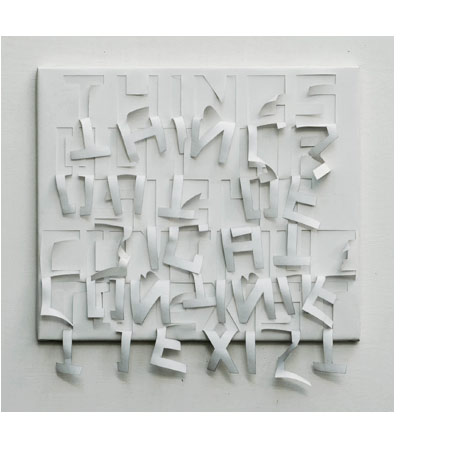
Things (white)
1999
cut canvas on canvas
55x65cm |
 |

Things (skywriting)
2000
cut paper
variable |
 |

Things (bucket)
2000
cut paper
variable |
 |

Things (pink, yellow, cut)
2000
acrylic on cut canvas
55x65cm |
 |

Things (green/pink/cut)
2000
acrylic on cut canvas
55x65cm |
 |

Things (white)
2000
cut canvas
100x80cm |
 |

Things (blue & white)
2000
acrylic on cut canvas
100x80cm |
 |

Things (black on black)
2000
acrylic on canvas
100x80cm |
 |

Things (table poem)
2000
cut paper
variable |
 |

Things
(The Daily Telegraph,14.12.02)
2002
newsprint & glue
60x37cm |
 |

Things (swing right, diptych)
2001
graphite on canvas
(2x) 35x40cm |
 |

Things (swing left, diptych)
2001
graphite on canvas
(2x) 35x40cm
|
 |
An artist cannot be a researcher in his own work.
It’s creative to misunderstand history.
Visual images cannot explain a text, and text cannot wholly explain an image. Both can make some kind of illustration of the other. They are not a substitute for one another.
What constitutes a text? Is it a mark, a sign, a letter, a word, a sentence, a poem, a statement, a narrative or a more complex form?
In a sense I have been finding out what constitutes a text via visual means. This has channelled my thoughts to find that single words are richer than whole sentences. They appear to be richer in their evocation of different meanings and non-meanings. Letting words be alone is rewarding.
Our interpretation of the past is continually changing. Historians are always amending it.
Art is something of a ‘mirror’ that reflects something of our collective being, conscious and unconscious.
Describing one’s own images in text can only be an inferior translation. Inferior translations usually result in re-writing the text, which removes it further from the original. This can provoke an embroidering of the text, or down right lies.
Lies, fantasies, individual whim and irresponsibility have no place in research. Research is balanced, reflected upon, double checked and never spontaneous. Within research it is hard to see the presence of art, which has no rules of conduct or procedure to which it is obliged to adhere.
It is doubtful if it is possible to make a work totally devoid of meaning.
Our collection was made with a strict attention to procedure. The string was first separated from the waste. Next all the knots were untied. Then the lengths of string had to be graded and sorted. Once sorted the lengths were knotted together and rolled into balls. The making of the string balls was also governed by rules and techniques, and they had a specific size.
Seeing, being more primal than reading, places a greater dependency upon intuition and native wit.






























